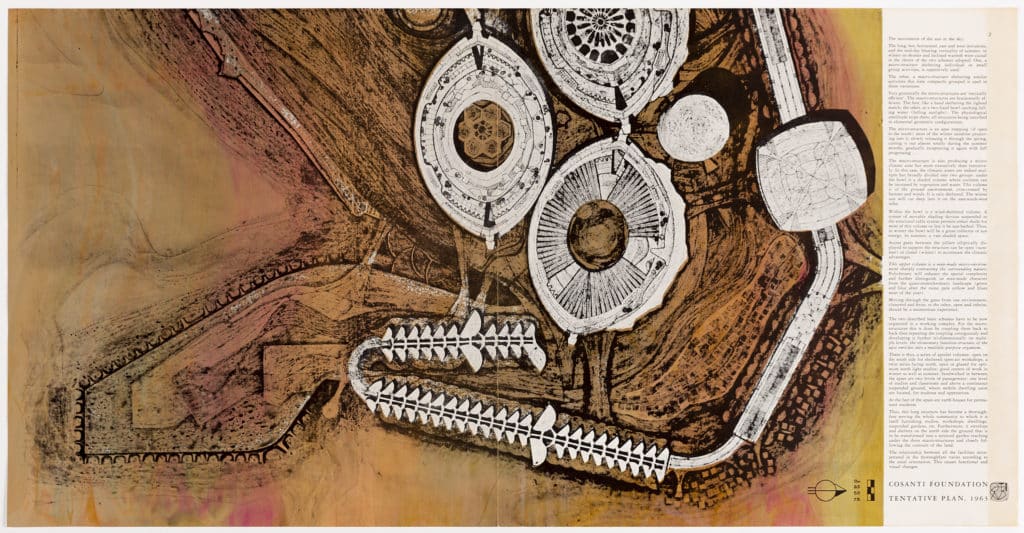Paolo Soleri

Over an advertisement for a series of workshops in the Arizona desert in 1979 ran the legend: ‘Soleri is in the desert not to escape the city for some pastoral dream but to create a wholly new urban civilization.’ It is not known when he started referring to himself in the third person but from 1956, the Italian architect Paolo Soleri lived in a complex he called the Cosanti foundation in Phoenix, Arizona, on a site just a few miles from Taliesin West, where Soleri had studied. The above poster is dominated by a highly tentative plan for the Foundation, which included a gallery and is an intriguing document of the complexities and contradictions inherent in a desert-based campaign to build a highly evolved, super-dense urban utopia.
The original drawing has apparently been done on a terracotta-coloured paper with the desert topology emerging out of layering of wax crayon and marker. On top of that a layer of correcting fluid has been added and the details of the structures added in ballpoint to that surface. Whilst the drawing bears very little relationship to what was actually built, the principles in the schematic text alongside very much informed the design of Cosanti, which was constructed using earth casting. Concrete was poured over pre-shaped earthen molds, and the earth excavated once the concrete had solidified. The ingenious use of correcting fluid within the folds of wax and pen evokes this wonderfully.
However, this is also a poster, a reproduction, part of the extensive means that Soleri employed to attract willing volunteers to help him build his far grander vision of ‘a wholly new civilization’ at Arcosanti – a larger site outside Phoenix in the Arizona desert. As his comments from 1979 make clear Soleri saw himself above the other designers of off-grid architecture, such as Mike Reynolds and Steve Baer, because of the sheer scale of the vision – which was to be achieved, furthermore, by co-opting unskilled, volunteer labour, still motivated by the vestiges of 1960s anti-establishment thinking, particularly the self-sufficiency movement in the south-west of the USA that had coalesced around Steward Brand’s Whole Earth Catalog.
Soleri was partly embarrassed by the rudimentary technologies he had been reduced to achieve his plan and would often disassociate Cosanti from his larger vision, even if it reflects his vision of the sun as a primary agent in the design of buildings. But the original drawing for this poster – featuring an original that evolves in layers out of the land – was selected to encourage a young generation into rolling up their sleeves and building a technologically sophisticated twenty-first century city in the desert with little more than shovels.

– William Firebrace